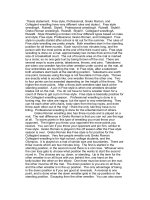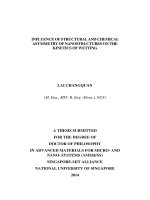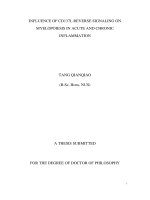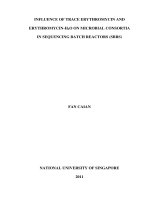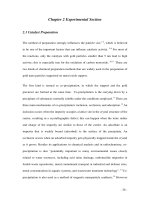Influence of different levels and concentration of micronutrients on growth and yield of Jamun (Syzygium cumini Skeels.)
Bạn đang xem bản rút gọn của tài liệu. Xem và tải ngay bản đầy đủ của tài liệu tại đây (261.65 KB, 7 trang )
Int.J.Curr.Microbiol.App.Sci (2019) 8(1): 2966-2972
International Journal of Current Microbiology and Applied Sciences
ISSN: 2319-7706 Volume 8 Number 01 (2019)
Journal homepage:
Original Research Article
/>
Influence of Different Levels and Concentration of Micronutrients on
Growth and Yield of Jamun (Syzygium cumini Skeels.)
G.N. Hemavathi1, S.V. Patil2*, G.S.K. Swamy3, R.L. Raghunath Reddy1,
K. Tulsiram1 and K.N. Sreenivas1
1
2
College of Horticulture, Kolar, Karnataka, India
RHREC, UHS Campus, GKVK, Bengaluru, Karnataka, India
3
College of Horticulture, Mysore, Karnataka, India
*Corresponding author
ABSTRACT
Keywords
Jamun (Syzygium
cumini Skeels.),
Micronutrients
Article Info
Accepted:
20 December2018
Available Online:
10 January 2019
The field experiment was conducted on Influence of different levels and concentration of
micronutrients on growth and yield of Jamun (Syzygium cumini Skeels.) The treatment
combination of 0.50% ZnSO4 + 0.20% Boron has recorded maximum increment in plant
height (53.57 cm), plant spread in N-S direction (48.47 cm) and E-W direction (49.40 cm).
Maximum stem height (0.44 m), canopy height (4.44 m), inter nodal length (2.80 cm),
number of new flushes (256.60), leaf area (74.00 cm2), number of panicles per m2 in north
(41.90), south (42.67) and west (38.33) direction, number of panicle per plant (223.33),
number of flowers per panicle (55.67), length of flowering panicle (16.50 cm), minimum
days taken from flowering to harvesting (85 Days), fruit set per panicle (42.33 %), fruit
number per plant (3767) and yield per plant (48.63 kg) was higher in 0.50% ZnSO 4 +
0.20% Boron. Maximum increase in fruit weight (12.88 g), fruit length (25.88 mm) and
seed weight (2.55g) was recorded in 0.50% ZnSO4 + 0.20% Boron. Further, the quality
parameters of fruits such as higher total sugar (8.14 %), reducing sugar (6.54 %) of fruits
was significantly improved with the above said combination of micronutrients.
Introduction
Jamun is known to be an indigenous and
important minor crop in India. It is a hardy
fruit crop. Its tree is very tall, evergreen in
semi-arid and partially deciduous under arid
conditions. Jamun is a tree attaining a height
of 25-30 m and a stem girth 3-4 m. It is a
beautifully shaped tree and is grown for its
delicious fruits, shade and windbreak on the
bunds road side avenues. Jamun is a crosspollinated crop. This long lived tree bears
fruits up to 60-70 years. Jamun belongs to the
family Myrtaceae. It has recently attained
importance as its fruit is appraised by the
diabetic patients. Fruit crops have high
potential and many uses, but they are not
cultivating on commercial basis because of
fewer varieties with long gestation period and
the plants, which are grown by seed, need
more care for fruiting.
It is widely grown in many parts of India from
Indo-Gangetic plains in the North to Tamil
2966
Int.J.Curr.Microbiol.App.Sci (2019) 8(1): 2966-2972
Nadu in the South (Singh and Srivastava,
2000). It has recently attained importance as
its fruit is appraised by the diabetic patients by
traditional practitioners over many centuries
and its various plant parts possess many
pharmacological properties. Not only it has
wonderful anti hyperglycemic properties, but
it has also proven antioxidant, antibacterial,
antigen toxic, anti-inflammatory and anti-HIV
properties (Sagrawat et al., 2006). The plant is
rich in compounds containing anthocyanins,
glucoside,
ellagic
acid,
isoquercetin,
kaemferol and myrecetin. The seeds are
claimed to contain alkaloid, jambosine, and
glycoside jambolin or antimellin (Swamy et
al., 2012).
Flowering and fruiting takes place in MarchApril and bear fruits from May to July.
Inflorescences are arise from the leaf axils of
branchlets. Flowers exhibit bisexual nature
and light yellow in colour. Some jamun
varieties put forth to second season in
October. Jamun is cross pollinated tree. It is
observed that fruit drop in jamun starts just
after fruit set and continues up to maturity.
Only 15-30 % fruits reach maturity. The
flower and fruit drop are found at three stages.
The first drop takes place during bloom or
shortly thereafter, this proves to be the harvest
drop as about 52 % of the flowers drop off
after four weeks from flowering.
The jamun growers are constrained with the
problem of irregular bearing or cropping
periodicity as well as reduced fruit set and
increased fruit drop which leads to
considerable loss of their production potential
in-turn leads to reduced yield. The
micronutrients like zinc and boron play a vital
role in fruit growth and development and their
application is found effective to solve these
problems. Keeping this in view the present
study was conducted to evaluate the response
of foliar application of micronutrients on
growth and yield of jamun at the Regional
Horticultural Research and Extension Centre
(RHREC), University of Horticultural
Sciences, GKVK campus, Bengaluru,
Karnataka-560065.
Materials and Methods
The present experiment was carried out during
2017-18 at Regional Horticulture Research
and Extension Centre, University of
Horticultural Sciences, GKVK campus,
Bengaluru, Karnataka-560 065. Seven year
old uniform plants of jamun was used which
are spaced at 6 m x 6 m (277 plants/ha). The
experimental design used was Randomized
Complete Block Design (RCBD) with 9
treatment 3 replications.
T1: Control, T2: 0.25 % ZnSO4, T3: 0.50 %
ZnSO4, T4: 0.10 % Boron, T5: 0.20 % Boron
T6: 0.25 % ZnSO4+ 0.10 % Boron, T7: 0.25 %
ZnSO4 + 0.20 % Boron, T8: 0.50 % ZnSO4 +
0.10 % Boron, T9: 0.50 % ZnSO4 + 0.20 %
Boron. The treatment was imposed at the time
of emergence of new flush, flowering and fruit
set stages. The micronutrients (zinc and
boron) at required concentration were
dissolved in the water and sprayed to jamun
plants.
The observations on plant height, plant spread,
girth, number of new flushes, number of
panicles per plant, length and width of panicle,
number of flowers per panicle, fruit set, fruit
number, fruit yield were measured. The plant
height was measured vertically from the
ground to tip of the tree and expressed in
centimeter. The tree spread was measured in
both North to South and East to West
directions using a measuring tape and
expressed in meters. Canopy spread was
recorded before initiation of experiment and at
six months interval and subsequent
measurements were taken at the time of
harvest and the increase in canopy spread
during the experiment was calculated. Girth of
2967
Int.J.Curr.Microbiol.App.Sci (2019) 8(1): 2966-2972
the stem was measured below and above the
graft union at a distance of 30 cm from the
union. Numbers of new flushes were counted
in all four directions of plant and mean of
them was expressed as the number of flushes.
Numbers of new emerged panicles were
counted in all four directions of plant and was
expressed as the number of new flushes.
Length and width of the flowering panicles
were measured in all the directions.
Mean length and width of flowering panicle
was calculated by measuring the length and
width of twenty panicles in all the directions
of the tree. The number of flowers per panicle
was calculated by counting the number of
flowers in panicles in all directions of the tree
and mean was calculated. The total number of
fruit set per panicle was recorded when fruits
were in pea nut size in tagged panicle in all the
four directions and mean was calculated. The
total fruits harvested during the season were
counted and expressed in numbers. The
weight of harvested fruits was expressed in
terms of kg per plant. This is referred as yield
per plant.
Results and Discussion
The data on above parameters are given in
table 1 to 5 and the results are discussed
hereunder.
Increment in plant height
The maximum increment of plant height
(53.57 cm) was observed in T9 (0.50 % ZnSO4
+ 0.20 % Boron) in (Table 1). This indicated
the positive combined effect of micronutrients
on plant height. The higher increment in
growth parameters might be due to the
combined effect of zinc and boron, where zinc
is known to increase the growth of plants by
auxin biosynthesis and boron helps in cell
division. Similar findings were reported by
Yadav et al., (2017) in gauva.
Plant spread
The maximum plant spread from North South direction (48.47 cm) and East-West
direction (49.40 cm) was recorded in T9 (0.50
% ZnSO4 + 0.20 % Boron) shown in (Table
2). Zinc is required for the synthesis of
tryptophan, which is a precursor of auxin that
might have resulted in increased apical growth
and boron helps in cell division and cell
elongation thus increased spread. Similar
results were reported by Yadav et al., (2017)
in guava and Kumar et al., (2017) in mandarin
oranges.
Girth of the stem above and below graft
union
The data related to stem thickness above and
below graft union in different treatments were
recorded in jamun cv. Chintamani (Table 3).
Foliar application of zinc and boron did not
alter the stem girth above and below the graft
union in jamun.
Number of new flushes
Number of new flushes was differed
significantly by foliar application of zinc and
boron in jamun. The maximum number of new
flushes (256.60) was recorded in T9 (0.50 %
ZnSO4 + 0.20 % Boron) in (Table 3). Zinc and
boron are essential component of enzymes,
responsible for nitrogen and carbohydrate
metabolism respectively, there by resulting in
increased uptake of nitrogen by the plant.
Further, involvement of zinc in the synthesis
of tryptophan, a precursor of indole acetic acid
synthesis, consequently increased tissue
growth and development.
Boron increases the phenolic compounds
which regulate polar auxin transport. The
increased auxin activity results in increased
number of new flushes and vegetative growth
characters.
2968
Int.J.Curr.Microbiol.App.Sci (2019) 8(1): 2966-2972
Table.1 Effect of zinc and boron on increment in plant height of jamun (3months after spraying)
Treatment
T1: Control
T2: 0.25 % ZnSO4
T3: 0.50 % ZnSO4
T4: 0.10 % Boron
T5: 0.20 % Boron
T6: 0.25 % ZnSO4 + 0.10 % Boron
T7: 0.25 % ZnSO4 + 0.20 % Boron
T8: 0.50 % ZnSO4 + 0.10 % Boron
T9: 0.50 % ZnSO4 + 0.20 % Boron
S.Em±
CD @ 5%
Initial plant height (m)
4.09
4.20
4.28
3.98
3.80
3.90
4.00
4.23
4.42
0.22
NS
Increment in plant height (cm)
35.73
38.60
43.07
41.17
39.27
43.97
44.53
46.82
53.57
2.99
8.95
Table.2 Effect of zinc and boron on extent of plant spread in jamun (3months after spraying)
Treatment
T1: Control
T2: 0.25 % ZnSO4
T3: 0.50 % ZnSO4
T4: 0.10 % Boron
T5: 0.20 % Boron
T6: 0.25 % ZnSO4 + 0.10 % Boron
T7: 0.25 % ZnSO4 + 0.20 % Boron
T8: 0.50 % ZnSO4 + 0.10 % Boron
T9: 0.50 % ZnSO4 + 0.20 % Boron
S.Em±
CD @ 5%
Initial plant
spread in N-S
direction (m)
4.27
4.10
4.23
4.33
4.03
3.87
4.23
3.93
4.00
0.21
NS
Increase in plant
spread in N-S
direction (cm)
39.53
39.50
42.63
43.20
43.77
45.53
46.03
47.53
48.47
0.58
1.74
Initial plant
spread in E-W
direction (m)
3.60
3.83
4.03
3.87
3.87
3.50
4.20
3.63
3.73
0.24
NS
Increase in plant
spread in E-W
direction (cm)
44.33
46.00
48.20
39.33
45.33
44.97
46.00
48.73
49.40
1.20
3.6
Table.3 Effect of zinc and boron on stem thickness above and below graft union and number of
new flushes in jamun (3months after spraying)
Treatment
T1: Control
T2: 0.25 % ZnSO4
T3: 0.50 % ZnSO4
T4: 0.10 % Boron
T5: 0.20 % Boron
T6: 0.25 % ZnSO4 + 0.10 % Boron
T7: 0.25 % ZnSO4 + 0.20 % Boron
T8: 0.50 % ZnSO4 + 0.10 % Boron
T9: 0.50 % ZnSO4 + 0.20 % Boron
S.Em±
CD @ 5%
Stem thickness Above
graft union(cm)
51.93
49.24
51.32
49.10
50.93
50.77
53.87
53.93
54.60
6.76
NS
2969
Stem thickness below
graft union (cm)
25.83
26.10
28.10
25.83
28.60
27.37
30.43
30.13
31.27
5.96
NS
Number of new
flushes
152.30
205.23
207.80
198.33
208.20
224.93
232.77
246.50
256.60
5.82
17.45
Int.J.Curr.Microbiol.App.Sci (2019) 8(1): 2966-2972
Table.4 Effect of zinc and boron on flowering parameters in jamun
Treatment
T1: Control
T2: 0.25 % ZnSO4
T3: 0.50 % ZnSO4
T4: 0.10 % Boron
T5: 0.20 % Boron
T6: 0.25 % ZnSO4 + 0.10 % Boron
T7: 0.25 % ZnSO4 + 0.20 % Boron
T8: 0.50 % ZnSO4 + 0.10 % Boron
T9: 0.50 % ZnSO4 + 0.20 % Boron
S.Em±
CD @ 5%
Number of
panicles per
plant
122.67
180.00
180.00
127.00
178.33
157.33
166.33
198.67
223.33
12.27
36.78
Number of
flower per
panicle
34.67
37.67
38.33
43.00
49.33
45.00
48.67
51.67
55.67
2.60
7.79
Length of the
flowering panicle
(cm)
11.67
12.10
12.33
13.30
15.10
14.33
15.47
15.97
16.50
0.57
1.72
Width of the
flowering
panicle (cm)
9.73
9.34
10.50
9.97
10.60
11.03
13.23
12.50
11.60
0.45
1.35
Table.5 Effect of zinc and boron on Fruit set, fruit number per plant and Yield in jamun
Treatment
Fruit set per
panicle (%)
Fruit number
per plant
Yield per
plant (kg)
T1: Control
T2: 0.25 % ZnSO4
T3: 0.50 % ZnSO4
T4: 0.10 % Boron
T5: 0.20 % Boron
T6: 0.25 % ZnSO4 + 0.10 % Boron
T7: 0.25 % ZnSO4 + 0.20 % Boron
T8: 0.50 % ZnSO4 + 0.10 % Boron
T9: 0.50 % ZnSO4 + 0.20 % Boron
S.Em±
CD @ 5%
17.00
23.00
21.33
24.33
33.00
33.33
39.67
40.67
42.33
2.05
6.15
2266.00
2499.00
2494.33
2949.00
3026.67
3215.00
3225.33
3222.33
3311.33
239.60
718.32
23.70
24.74
25.55
30.81
31.66
36.39
37.34
39.42
42.59
1.26
3.78
Number of panicles per plant
The data related to number of flower panicles
per plant after micronutrient application was
significantly influenced by foliar application
of zinc and boron (Table 4). The highest
number of flower panicles (223.33) was
recorded in T9 (0.50 % ZnSO4 + 0.20 %
Boron). This might be due to fact that zinc
and boron, being important elements involved
Increase in yield
over control
(%)
4.38
7.80
30.00
33.58
53.54
57.55
66.32
79.70
-
in reproduction, play an important role in
enhanced flower bud initiation which leads to
increased number of flowers and flowering
panicles.
These findings are in agreement with the
observations of Chandra and Singh (2015) in
aonla who opined that zinc is the element
present in activating several dehydrogenase
and proteinase enzymes and involved in the
2970
Int.J.Curr.Microbiol.App.Sci (2019) 8(1): 2966-2972
biosynthesis of auxin, which promotes
flowering and fruit setting of many plants.
Length and width of the flowering panicle
The data pertaining to foliar application of
zinc and boron significantly influenced the
length and width of the flowering panicle in
jamun during 2017-18 (Table 4). Among
different levels of foliar application,
maximum length of flowering panicle (16.50
cm) was recorded in T9 (0.50 % ZnSO4 + 0.20
% Boron) and maximum width of flowering
panicle (13.23 cm) was recorded in T7 (0.25
% ZnSO4 + 0.20 % Boron), zinc and boron
induces maximum length of panicle due to
combine effect of micronutrients involved in
activation of enzymes, protein synthesis and
photo assimilates as well as translocation for
efficient cellular activity. Auxins activated by
zinc might have increased the length and
width of panicle through cell division and cell
elongation in the shoot apex. Similar findings
was reported by Venu et al., (2014) in kagzi
lime.
Number of flowers per panicle
Highest number of flowers per panicle (55.67)
was recorded (Table 4) in T9 (0.50 % ZnSO4 +
0.20 % Boron) application of boron increases
flower numbers and act its role in pollen tube
germination and elongation and also regulates
metabolism involved in translocation of
carbohydrates, cell wall development and
RNA synthesis. This is in conformity with the
findings of Gurung et al., (2016) in darjeeling
mandarin.
Fruit set per panicle
The fruit set per cent was significantly
influenced by the foliar application of
micronutrients in jamun (Table 5). The
highest fruit set per cent (42.33 %) was
observed in T9 (0.50 % ZnSO4 + 0.20 %
Boron) it might be the effect of boron which
plays important role in developing
reproductive organs (anthers, style, stigma
and ovary), ovule development, pollen tube
growth and fruit set.
Fruit number per plant
The highest fruit number per plant (3311.33)
was observed (Table 5) in T9 (0.50 % ZnSO4
+ 0.20 % Boron).Boron is a constituent of cell
membrane and essential for cell division.
These results may be comparable with the
findings of Singh et al., (2007) in anola who
have also reported that zinc application
reduces the incidence of fruit drop because of
the fact that it maintains the ongoing
physiological and chemical processes related
to inhibition of abscission there by increases
fruit set and fruit number.
Yield per plant
The yield per tree was significantly
influenced by foliar application of zinc and
boron (Table 5). The highest yield (42.59 kg)
was recorded in T9 (0.50 % ZnSO4 + 0.20 %
Boron). Zinc plays an important role in auxin
biosynthesis which leads to reduction in fruit
drop and higher fruit setting. Meanwhile, the
application of zinc and boron might have
caused rapid synthesis of protein and
translocation
of
carbohydrate
which
ultimately led to increase in fruit weight
which is directly correlated with total yield
(Singh et al., 2012).
References
Chandra, R. and Singh, K.K., 2015, Foliar
application of zinc sulphate, magnesium
sulphate and copper sulphate on the
yield and quality of aonla (Emblica
officinalis Gaertn.) cv. “NA-7” under
Garhwal Himalaya, J. Med. Plants
Stud., 3(5): 42-45.
2971
Int.J.Curr.Microbiol.App.Sci (2019) 8(1): 2966-2972
Gurung, S., Mahato, S. K., Suresh, C. P. and
Chetrri, B., 2016, Impact of foliar
application of growth regulators and
micronutrients on the performance of
Darjeeling Mandarin. Am. J. Exp.
Agric., 12(4): 1-7.
Kumar, N. C. J., Rajangam, J., Balakrishnan,
K. and Sampath P. M., 2017, Influence
of foliar application of micronutrients
on yield and quality of mandarin orange
(Citrus reticulata Blanco.) under lower
pulney hills. Intl. J. of Agri. Sci., 9(17):
4151-4153.
Sagrawat, H., Mann, A. S. and Kharya, M. D.,
2006, Pharmacological potential of
Eugenia jambolana. Pharmacog Mag.,
6(2): 96-105.
Singh, E. S. and Srivastava, A. K., 2000,
Genetic diversity - Jamun (Syzygium
cumini Skeels). Indian J. Hort., 45(3):
2.
Singh, J. K., Prasad, J. and Singh, H. K.,
2007a, Effect of micro-nutrients and
plant growth regulators on yield and
physic-chemical characteristics of aonla
fruits in cv. Narendra Aonla-10. Indian
J, Hort., 64(2): 216-218.
Singh, P.C., Gangwar, R.S. and Singh, V.K.,
2012, Effect of micronutrients spray on
fruit drop, fruit quality and yield of
aonla cv. Banarasi, Hort. Flora
Research Spectrum, 1(1): 73-76.
Swamy, S. B., Thakor, N. J., Patil, M. M. and
Haldankar, P. M., 2012, Jamun
(Syzygium cumini, Skeels): A review of
its food and medicinal uses. Food and
Nutrition Sci., 3:1100-1117.
Venu, A., Delvadia, D. V., Sharma, L. K.,
Gardwal, P. C. and Makhmale, S., 2014,
Effect of micronutrient application on
flowering, fruiting and yield of Acid
lime (Citrus aurantifolia L.) cv. Kagzi
lime., Int. J. Trop. Agric., 32: 3-4.
Yadav, P., Sharma, J. R., Rupakshi, Baloda,
S. and Kant, G., 2017, Influence of
Foliar application of nutrients on
growth, flowering, fruiting and yield of
Guava (Psidium guajava) cv. L-49. Int.
J. Pure App. Biosci., 5 (5): 1217-1222.
How to cite this article:
Hemavathi, G.N., S.V. Patil, G.S.K. Swamy, R.L. Raghunath Reddy, K. Tulsiram and
Sreenivas, K.N. 2019. Influence of Different Levels and Concentration of Micronutrients on
Growth and Yield of Jamun (Syzygium cumini Skeels.). Int.J.Curr.Microbiol.App.Sci. 8(01):
2966-2972. doi: />
2972



